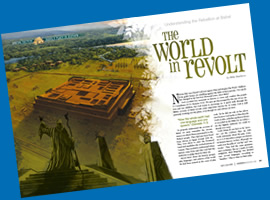What words come to mind when you think of the events that took place at the Tower of Babel: rebellion, judgment, confusion, scattering, separation? While these words accurately describe different aspects of this event, more importantly, each one represents valuable lessons that we can learn from this history-altering event.
The special “Tower of Babel” issue of Answers magazine covers some fascinating aspects of the Babel account as recorded in Genesis 11. Here is a preview of some of the articles you will find in the April–June 2008 issue:
- “The World in Revolt” — Answers magazine editor Mike Matthews reveals some insightful things in this verse-by-verse look at Genesis 11:1–9. Has mankind’s rebellious heart really changed in the last four thousand years since Babel?
- “What Did the Tower Look Like?” — How much do we really know about the size and shape of the Tower? This short article addresses this much-asked question.
- “Egypt or Babel: Which Came First?” — You don’t have to be an expert in biblical chronology to find the answer to this question. And what about the pyramids? When were those built? You’ll find the answer to these questions and more.
- “Pop Cultures of Antiquity” — How quickly did civilizations form after the Tower of Babel? Did they appear suddenly or gradually over tens of thousands of years? Diana Waring, author of Answers in Genesis’s new history curriculum Ancient Civilizations, answers this question as she presents discoveries in the archaeological record.
- “Ur Connects Babel to Today” — Dr. David Livingston, the founder and former director of Associates for Biblical Research, discusses how life in the city of Ur (the birthplace of Abraham) gives us clues about the Tower of Babel.
Babel’s Connection to Our World Today
The effects of God’s judgment on the rebellious settlers at Babel can still be felt today. This time in history explains much of what we see today in our government, languages, people groups, and much more.
The following articles show the connection Babel has on our world today:
- “One Nation over God” — Founder and president of Vision Forum Ministries, Doug Phillips, shows how Babel explains the role of our modern government.
- “More Than PIE” — Linguist expert Dr. John Oller, Jr., shows how the Tower of Babel explains why there are so many language families, including the Proto-Indo-European (PIE) family.
- “Tongue-Twisting Tales” — Are there worldwide legends about language like there are with flood legends? Find out in this fun look at these tales from afar.
- “It’s Not Just Black and White” — Ken Ham explains how the rise of people groups can be traced back down to the Tower of Babel. While we are all “one blood,” can there really be such a thing as “black” and “white” twins? Find out in this engaging article.
Beyond Babel
This issue also digs deeper into some other fascinating topics such as fossils, genetics, geology, and monarch butterflies.
- “Lucy Was Buried First” — Dr. Kurt Wise answers the question of why we find apes in fossil layers before humans.
- “Four Women, a Boat, and Lots of Kids” — Remember Mitochondrial Eve? Dr. Todd Wood takes a fresh look at what DNA tells us about where we came from. Did our ancient ancestors come from Africa or out of Babel?
- “The World’s a Graveyard” — Dr. Snelling continues his ongoing series on the six main geologic evidences for the Genesis Flood in this sneak peek in-depth look at massive graveyards all around us.
- “The Marvels of the Monarch” — Former wildlife biologist, Donna O’Daniel takes us on a journey through the life cycle of a monarch butterfly and its incredible ability to migrate south during the fall.
Kids Answers and Chart
Kids will love matching the fuzzy caterpillars with the beautiful butterflies on the colorful pull-out poster. They’ll also learn about the life cycle of monarch butterflies and some other interesting facts. The pull-out chart provides a great reference for parents and teachers on the various ways that Babel explains our differences.
As you’ll see as you thumb through the pages of this issue, the events that took place at the Tower of Babel go beyond a simple lesson in history. Packed in these pages are relevant lessons we can learn and apply to our lives today. Who will you share this knowledge with?
